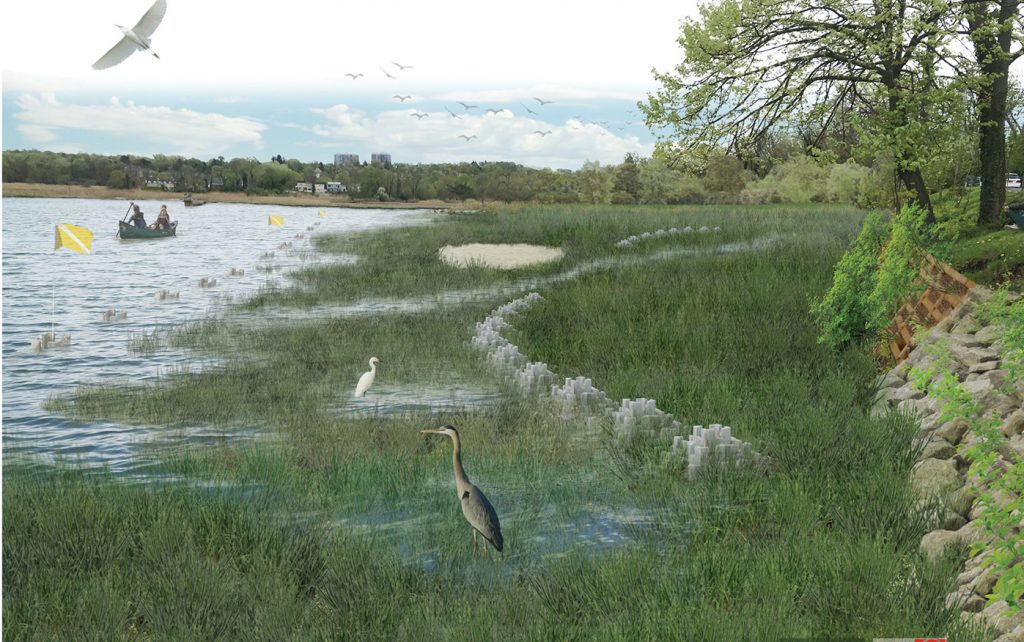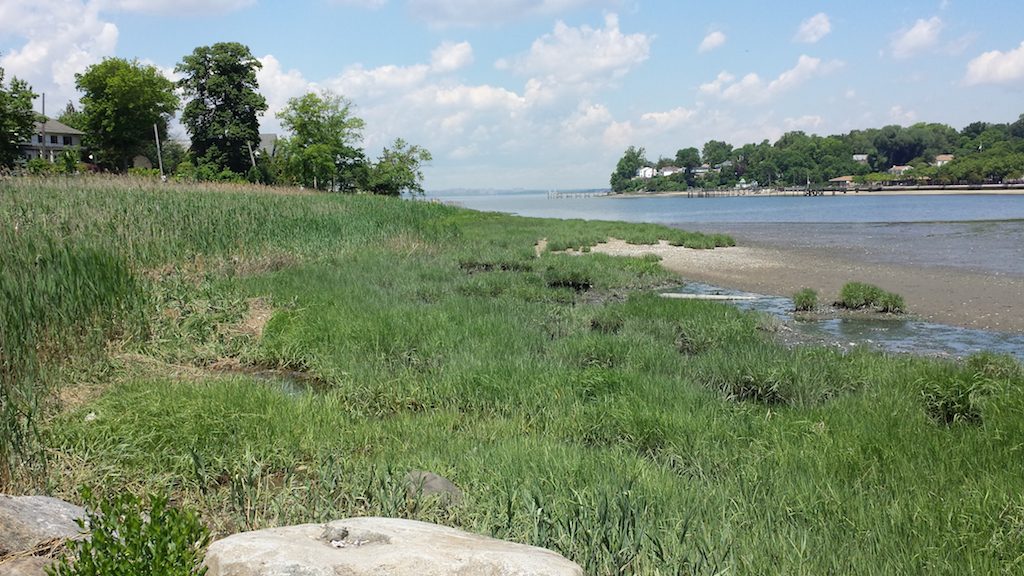By Katie Friedman, NY ecological restoration program manager, and Melissa Pappas, ecological communications specialist
Coastal communities, home to almost a third of Americans1, are facing sea level rise and erosion. While we may think of these consequences as distant and future threats, they are already taking hold of local communities.

This rendering depicts the living shoreline to be installed as part of the Big Rock Wetland Restoration Project.
Artistic rendering provided by GEI and DMEA.
The residents of Douglas Manor, a community in Queens, New York, have not ignored these threats; rather, they have been preparing for coastal erosion for the last decade. Their neighborhood overlooks Little Neck Bay, one of the many bays in Long Island Sound, and it is this proximity to the water that puts them at risk. Their community roads, playing fields, and parks are threatened by coastal erosion due to sea-level rise and storm surges. To combat this, community leaders of the Douglas Manor Association and the Douglas Manor Environmental Association came to Save the Sound with a plan to install a living shoreline that will help mitigate erosion. With funding recently secured thanks to supportive champions in Congress and the Long Island Sound Futures Fund, Phase I will be mobilized and the team can now turn their many years of planning into a reality.
“The Big Rock Wetland Restoration Project began more than eight years ago as a dream to restore this degraded wetland—and it has evolved to become a community partnership with many neighborhood organizations and local schools deeply involved,” said DMEA board member Jamie Sutherland, who co-chairs the Big Rock Wetland Restoration Project Committee. “The Douglas Manor Environmental Association is absolutely thrilled to be receiving this funding and beginning Phase I of construction with our partner, Save the Sound.”
The living shoreline proposed for Big Rock is the preferred solution to shoreline stabilization and restoration2. Living shorelines replace hard edges such as concrete and riprap with plants, sand, and/or natural reef building materials such as oyster castles to hold the shore edge. They are a more eco-friendly and resilient buffer against destructive forces of wind and wave action when compared to the hard edge of a seawall. In fact, a seawall can increase the destructive force of waves as it does not allow for the dissipation of energy; a natural and sloped edge made of plants, sand and/or rock, decreases the force by dispersing wave energy. And, a living shoreline’s functions improve over time as the plants take hold and reef-building organisms grow.

As sea levels rise, both wildlife and people are at risk of losing their homes. While the residents of Douglas Manor are concerned about the resiliency of their neighborhood, they are also aware of how climate change affects the plants and animals on their shoreline. Currently, the shoreline is dominated by an invasive marsh plant, Phragmites australis, which out-competes all other plants, decreasing both plant and animal biodiversity. These invasive reeds will be removed and native plants will be planted, which will encourage a wide variety of birds and wetland animals to come back. To better understand that ecological impact, New York Audubon will conduct bird surveys before and after the living shoreline is installed.
“Growing up as a young girl along the Long Island shoreline, I’ve always appreciated the amazing migratory shorebirds that visit every year, and as I’ve grown older and seen the world change, I’ve felt a connection to protecting this beautiful habitat and the birds whom call it home,” said Sutherland. “I started the Big Rock Wetland project in an effort to create a healthier environment for the wildlife I love.”
During the first phase, the project team will restore a stretch of degraded shoreline along the main playing field by installing 600 linear feet of oyster castles and planting native coastal species. This will restore one acre of native salt marsh and oyster habitat, while creating conditions that allow for marsh migration as sea level rises—otherwise difficult to achieve in an urban environment. The Big Rock wetland restoration is just one example of the climate change solutions that Save the Sound provides to increase ecosystem and community resilience in Long Island Sound’s watershed. ■
References:
1 – US Census | Emergency Management Coastal Areas
2 – | Understanding Living Shorelines




